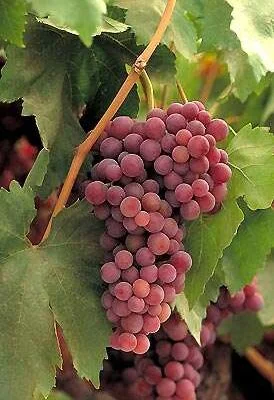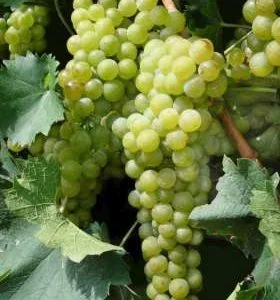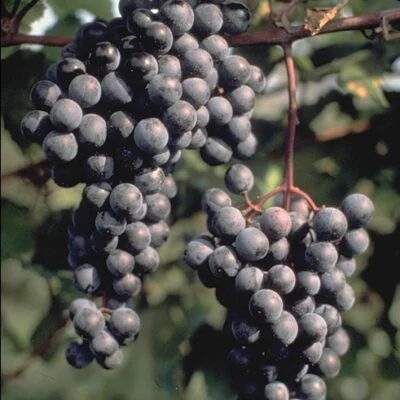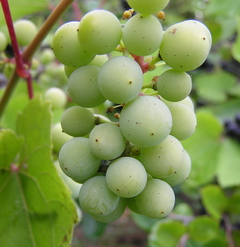Your basket is currently empty!
How to Grow Grapes
Grapes are climbing vines with terndrils so will need support of a trellis, post and wires or do well against a sunny wall. There are varieties better for outdoor growing and also types for indoor greenhouse growing. They need plenty of sun to ripen the fruits. Pruning as a cordon trained vine increases yield and saves space.
Growing grape vines can easily be done in the UK either in a greenhouse or outdoors. There are plenty of varieties of grapevine suited to the UK climate and it is important that it is these varieties that are chosen rather than those that are grown on the continent in warmer climates.
Most gardeners at some point will have the desire to plant a grapevine and as realization slowly dawns across the gardening population that it is perfectly possible to grow these hardy climbers in this country then viticulture popularity will surely continue to grow.Whether your interest is in purely dessert grapes, or you fancy yourself as a wine-maker extraordinaire, there are bound the be suitable varieties for your area.
A wide range of Grape vines can be viewed here
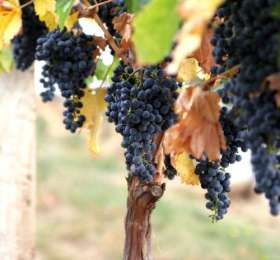
The grape vine is a climber, and a very ornamental one. It must have support of some kind but it is quite flexible and dynamic as well so with a little forethought you are bound to be able to find space somewhere in the garden or greenhouse.The big palmate leaves often colour decoratively in the Autumn, infact some closely related Vitis are grown purely for ornamental value although Vitis coignetiae will produce bunches of fruit too. But our attentions here are solely on the many varieties cultivated for the quality and productivity of their fruit.
Growing grape vines in a greenhouse
Often the ultimate in quality and flavour comes from those vines cultivated under glass. This can be a lean-to, a conservatory, a sun lounge or a greenhouse, it doesn’t matter. They cannot be cultivated in a room or house even where light levels are excellent because the atmospehere is too dry. If you live in the North, although there are outdoor varieties suited to be grown there, the best results are likely to be gained from those grown indoors.
There are two planting methods – the root can be planted outside against the wall of the greenhouse, and the top trained in through a small hole. This is the most popular method – or the roots can be planted in a border inside or in a container. The latter cultivation technique has the advantage of the soil being warmer which will result in earlier, and possibly more profuse, growth. But you must be fastidious about watering because there will of course be no natural rainfall. Planting the rootball outside means that for most of the time the vine will be watered naturally, but growth may be slower and more latent because the soil surrounding the roots will be colder.For planting inside a greenhouse or similar structure, you will probably have to import the planting medium, whether it is in a border or a container. You should aim to create a fairly porous mix of about 60% loam, 20% peat and 20% coarse grit. Extra fertilizer can be added, a dusting of bonemeal is ideal. If you prefer to buy a ready made compost then John Innes no 2 with some added peat and grit will do. In all cases the vines require good drainage.
Siting you vine will depend on what space is available but always try to give as much sunshine as possible to ripen the fruits well for good colour and higher sugar levels. Huge amounts of space are not necessary and even small structures can accommodate a grape vine. Although traditionally grapes were often allowed to ramble at will and form quite large specimens, often to spectactular effect, modern systems involve proper pruning to keep them within manageable proportions and to encourage fruiting rather than excessive growth. Even commercial vineyards are cultivated in this way to make the best use of land.
Training your grapevine
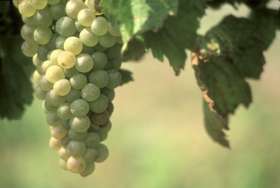
There are two main growing systems. The cordon [Guyot] method and the fan [rod and spur] system. The latter is usually used for indoor vines but the two are interchangeable.
You will first need to erect a suitable supporting framework for your vine to be tied to, the alternative is to affix straining wires to the side of the greenhouse if appropriate, either way you will need 3 straining wires taughtly in place at 18” intervals until a height of about 6’ has been reached.To train your vine as a fan, the first year you should allow just one main stem to develop, any side shoots should be kept pinched back to one or two leaves. At the end of the first year, this one main stem should be cut back to 15-18” from the ground. This will result the following Spring and Summer in several new shoots breaking out and these should be trained up vertically as they grow. Then in late Autumn of that year, tie one shoot down horizontally to the left and one shoot down to the right leaving one vertical shoot which should then be cut back leaving just 2 or 3 buds. You should now have a vine that looks a bit like a ‘T’ in shape. Don’t worry about tying the shoots down, they should still be quite flexible and pliable.
During the second summer train 2 or 3 shoots from the central stem which you cut back, pinching back any side shotos that arise from these new stems. Once they have reached the desired height they can be trimmed off. In the meantime the original two lower laterals that you tied down flat will have numerous new shoots growing up vertically; some of these you can tie in and others you can trim off. You will now have a nicely shaped ready to fruit vine.
The cordon [Guyot] system is simpler and takes up less room but cropping is not as good and it isn’t as attractive when it is trained, but it is still a very satisfactory and sensible method of training. You can allow one main stem to develop, or two.
After planting the vine is cut back to a third of it’s original growth. Any remaining side laterals [there may or may not be some] should be cut back to 1”. The vine will produce strong new growth that summer, leave that to grow but any further side shoots should be kept trimmed right back. Then in the second Autumn cut the vine back to about 36” and side laterals from this main stem to one bud.
The following growing season will see the main stem extend vigorously again, late that year it should be pruned again by about half. Side shoots should be shortened to 1 inch.
The next January untie the vine and pull the top of the stem down towards the ground; this will encourage the buds to grow upwards and at this point you can tie up the main stem again back to where it was. Your vine is now ready to flower and fruit and all that needs to be done now is pinch the growing tips out just beyond the flowers. The main growing shoot will continue to grow strongly and it can now simply be tipped when it has reached the desired height.
Each December thereafter all new laterals can be shortened to an inch. The main leader can be kept pruned in height as to your wishes.
Pollinating the flowers
Growing in the greenhouse, sun lounge or conservatory will mean there is bound to be a lack of pollinating insects around. Keep an eye open for the developing flower trusses- these don’t look much like flowers at all but are merely a much branched greenish panicle with buds. These should, on opening be hand pollinated with a feather or soft haired brush, go over each ‘bunch’ fastidiously, transmitting pollen from one to the other to ensure a good even fruit set. All varieties are self fertile so pollen from the same vine will be satisfactory.
Planting the grape vine
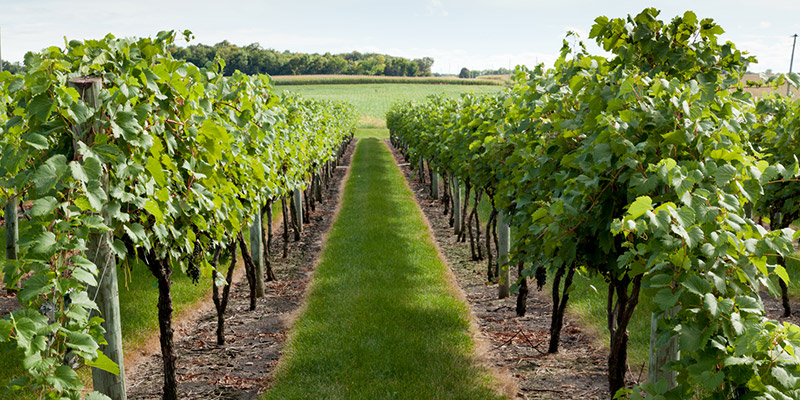
These instructions apply to vines grown indoors or outdoors. Vines can be transplanted at any time of year as they will almost invariably be supplied in containers. Planting can therefore be carried out when you wish but late Autumn is often considered a good time because initial pruning can take place straight away, otherwise you will have to wait to prune the next November following planting but at least the vine will be well established. If the plant looks congested in it’s pot, tease out some of the roots so that they can establish in their new home. If the pot is dry water it thoroughly prior to planting. You should make sure your supporting wires are in place before you plant. The hole should be just big enough to take the rootball as it is and should be at the same depth as it was. Firm well and puddle the vine in to settle in the new soil. Further watering will be required daily until established, if it has been planted whilst in growth. Dormant vines require less upkeep in the months following planting, until they bud p in the Spring.It should be noted here that Grape Vines are usually quite late coming into growth. All around them – in the garden, or the greenhouse – springs into life and looks promising whilst the Grape continues to look dispirited and lifeless – and do they look lifeless! The stems are shrivelled and a dull brown, it almost seems impossible that they could be alive. But spring forth they do, when ready. This is often May outside, maybe a little earlier indoors. So don’t despair or give up on your new Grape Vine the first spring, after that you will be accustomed to their peculiarities!
Feeding Grape vine plants
Like everything in the garden or greenhouse, the more you put in then the more you get out and Grapes are no exception. They need a regular food source to reward you. For vines that are growing in the open ground a good balanced N.P.K fertilizer, or Growmore, may be applied in February or March before growth starts. This should be applied at 2oz’s per square yard. At the same time also give half an ounce of potash which encourages greater yields.
For plants in containers I recommend Miracle Grow or Osmocote tabs in combination with regular foliar feeds of Maxicrop.Watering is very valuable to grapes as it encourages a greater set and bigger berries. But it has to be done at the right time. You can commence a regular watering schedule from late March or early April; really soak the ground once a week and continue through the growing season. Water in the early morning so that the water given has the greatest effect. This is particularly important for vines grown indoors but is also beneficial to outdoor grapes where the soil or conditions are dry. It is important that you stop excess irrigation in early Autumn. If you continue to provide extra water then you risk splitting the fruits.
Harvesting
Wait until your grape trusses are fully ripe before harvest. If growing dessert varieties sample one or two fruits at intervals after they have ‘coloured up’ to see if they are sweet and juicy enough to enjoy. Weighty trusses should be cut with sharp scissors or secateurs, never pulled off the vine which could cause damage. Bear in mind that late varieties can be well into November before they are fully ripe. These types are best grown indoors and sometimes appreciate some heating as the nights get colder to ensure they ripen properly. With grapes grown for wine making ripening is less important but they should still be fairly tender and have a good juice content but don’t expect them to develop the sugar levels appropriate to dessert types.
The best spot for outdoor varieties
If you are growing grapes in a greenhouse or similar structure you don’t have to worry about siting or variety selection. But when it comes to growing outdoors you need to be more particular on both counts. The lonher the sun shines on your vines then the more successful it will be and the better the bunches will ripen. A south or west facing wall or pergola is absolutely ideal and with all that added sunshine and warmth the vines of most varieties will do spectacularly well. You can also grow vines in containers outdoors and again some shelter on the patio, and maximum amount of sun, cannot be stressed too highly,. Don’t try to utilize east or north facing walls and fences and, although the vines may grow in the shade they may never be very productive.
When browsing specialist fruit growing websites you will usually see the list of available varieties segregated into ‘indoor’ and ‘oudoor’ varieties. It should be noted that outdoor varieties may be grown indoors as well but indoor varieties should only be grown indoors unless your aspect is very favourable.
If you live in the North or have an unpromising garden it is still possible to grow grapes of the hardier varieties. Theresa, Boskoop Glory, Madelaine Sylvaner, Phoenix and Early van der Laan are all recommended. It is often suggested that the green varieties are hardier than the red or blue types.
Mildew
Is the greatest single threat to the quality of your Grape crop. It can quickly ruin foliage and fruit if it is not kept in check and this is because so often the vines are grown in circumstances with poor air circulation – be it against a wall, or in a greenhouse.
There are three key elements to consider when trying to avoid this unwelcome fungus. You can either grow varieties that are mildew resistant, of which there are a few and this will be noted against there descriptions from your supplier. Such varieties may still get some mildew under periods of extreme stress but the disease will generally be much less of a problem. Secondly you can main a prohibitive spray programme using a broad spectrum fungicide. And largely you can employ pruning best-practices as described previously in this article. This will prevent the vines from getting too congested and thus discourage mildew from having such a field day.
Other diseases of grape vines
Capsid bugs can sometimes cause damage to the leaves. Although not a serious pest you don’t want the leaves torn with unsightly holes so apply a suitable insecticide as soon as you notice any damage.
Whitefly can sometimes infest vines grown under cover. Any pyrethrum based Insecticide should discourage these insects and of course biological controls can also be used.
Thinning the fruits
From mid summer the berries on the trusses start to swell quite quickly. If you do nothing at this point you will probably end up with a great number of handsome fruit trusses crammed with small fruits. This may well satisfy you but if you favour larger grapes then some thinning is desired as this will increase the size of individual fruits because the vine does not have so many to carry to maturity. Small sharp scissors are required, the knack is to leave those on the ‘shoulders’ of the bunch, and those on the outside, and remove several of the inner fruits, and then commence on those smaller fruits as well. It is never advisable to pick them off by hand and avoid handling the bunches as much as possible because this destroys the attractive waxy ‘bloom’ on the surface of the fruits, and you can also inadvertently bruise or damage them too. You should also examine the bunches regularly as they begin to mature, and remove any split, damaged or rotten fruits so they do not infect the remainder.
Growing the best seedless grape vines
Years ago of course no grapes sold in the shops were seedless and we were used to those annoying pips;. Nowadays I would say over half of all sales of Grape Vines for amateur use are of the seedless variety. This isn’t an ideal situation because there are few seedless varieties that can produce reliably in our climate. If you live in the south or have a nice protected position then give them a go by all means. And if you are growing under cover/the greenhouse then they will do well. But otherwise I would strongly recommend going with seeded varieties for the best results, if you can possible learn not to be annoyed by all those pips. Of course if you are growing for wine or juice making then the pips are not an issue because they will be strained off at some point anyway.
The three best seedless grape varieties for the UK climate are Lakemont Seedless,[pictured below] Flame, and Suffolk Red Seedless. It should be noted here that even ‘seedless’ varieties may produce some seeded fruit if the vine has been stressed or conditions aren’t ideal.
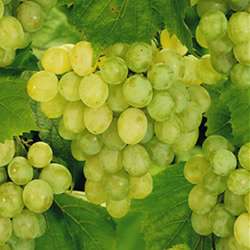
Grapes with Autumn foliage
If you want your vine to double as an ornamental – as so many of them will – then no doubt you will have seen or heard of the spectacular array of foliage colours that are available from some varieties. The variety ‘Brandt’ is by far the most famous Grape variety known for the brilliance of it’s decadent ruby red autumn leaf colour. It shines like sunlight through a stained glass window. Spectacular! It’s hardy and produces good blue-black grapes too. Another that reliably turns red here is the newer variety ‘Regent’ which is mildew-free and reliable too. So give your pergola [or wall] a treat and plant something productive and spectacular!
Good dessert varieties of Grape
If your desire is simply for divinely sweet and juicy grapes that you can eat fresh as soon as they are ripe then here is a list of the best ones to grow:
- Theresa [white green outdoor]
- Buckland Sweetwater [green indoor]
- Black Hamburgh [black indoor]
- Boskoop Glory [blue outoodr]
- Fragola Strawberry Grape [red indoor and out]
- Alicante [blue black indoor]
- Royal Muscadine [white green indoor]
- Bacchs [green outdoor]
Growing grapes in pots and containers
Whether indoors or out some pointers should be observed when cultivating grape vines in pots. This is perfectly do-able of course, employ a good restrictive pruning regime such as the Guyot [cordon] method and give them a generously sized container – a half barrel is ideal, if not a 24-30” container is usually ample. A loam based compost mixed with some extra plain peat is an ideal medium; raise the container onto little feet so that drainage is top notch. Any variety of grape can be grown in a pot, I wouldn’t say some are better than others. The individual qualities of the various cultivars apply equally whether they are container grown or in the open ground.
A regular watering regime is essential as vines grow fast, produce a lot of leaf, and are generally quite ‘thirsty’ plants. So try to stick to a daily watering programme, once in the early morning and really puddle the compost direct to the roots. You must continue this throughout the growing season – which for grapes is really from late April to October. But reduce the watering somewhat as the fruits begin to mature in the Autumn, so as not to increase the risk of fruit splitting.
Extra feed should be given with maxicrop, Osmocote tablets, or maxicrop.
Additional ways of growing
Wherever there is sun and suitable support it is possible to grow Grape Vines successfully. I have seen wonderful fruiting examples being grown over outbuildings, providing a perfect camouflage. Up telegraph poles, trained along low walls, and through trees and over tree trunks. Always choose the sunny side on which to plant. With most of these situations it isn’t really necessary to follow a strict pruning regime and you can just let the vine go, curbing and tying in as necessary. Cropping might be delayed slightly but once they get going you can still expect a significant yield.Bear in mind on walls and most of the above suggestions, some support system will be necessary because the tendrils of the vine can’t cling direct to walls and plaster, let alone a tree trunk. Make sure some mesh or netting, or a few wires are attached before planting your vine, just to get them going. They are generally classed as self-supporting as long as there us something to cling to.
Good grape varieties for outdoor growing
- Phoenix [green]
- Theresa [white
- Regent [blue red]
- Queen of Esther [red]
- Boskoop Glory [blue black]
- Muller Thurgau [green, wine grape]
- Madelaine Sylvaner [green white, wine]
- Early van der Laan [green]
- Dornfelder [blue black]
- Precoce de Malingre [golden]
- Bacchus [white-green wine]
Good indoor grape varieties
- Muscat Alexandria [white table grape]
- Buckland Sweetwater [green]
- Black Hamburgh [black]
- Rembrandt [blue black]
- Gros Maroc [large deep blue]
- Fosters Seedling [green]
- Chasselas Rose [pink-rose]
- Royal Muscadine [white]




